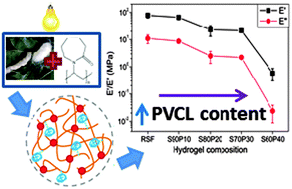Engineering DN hydrogels from regenerated silk fibroin and poly(N-vinylcaprolactam)†
Abstract
The development of novel hydrogels that possess adequate elasticity and toughness to withstand mechanically active environments, along with being biocompatible, remains a significant challenge in the design of materials for tissue engineering applications. In this study, a family of regenerated silk fibroin (RSF) based double network (DN) hydrogels were fabricated for the first time using a rapid one-pot method. The DN hydrogels combine the rigid covalently crosslinked RSF with the softer poly(N-vinylcaprolactam) (PVCL) through strong physical interactions. The formation of these DN hydrogels resulted in an improvement of the water uptake capacity, elasticity and toughness compared to the individual RSF hydrogel. The elasticity of the RSF/PVCL DN hydrogels was closer to that of native cartilage, which makes them promising materials for cartilage regeneration applications. An in vitro study on adhesion, proliferation and differentiation of a mouse pre-chondrocyte cell line (ATDC5) conducted using microscopic analysis, a cell proliferation assay and RT-PCR confirmed the cells cultured on the less stiff hydrogels demonstrated the most favourable chondrogenic response. Thus, this study demonstrates the potential of RSF-based hybrid hydrogels for cartilage tissue engineering applications.


 Please wait while we load your content...
Please wait while we load your content...